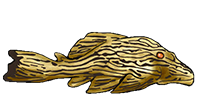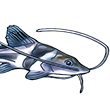ID?
- yellowcat
- Posts: 142
- Joined: 08 Sep 2004, 22:15
- I've donated: $125.00!
- My images: 74
- My cats species list: 39 (i:37, k:15)
- Spotted: 44
- Location 1: Los Angeles
- Location 2: USA
- Interests: auchenoglaninae, pimelodidae, pseudopimelodidae, doradidae
Re: ID?
They're definitely a Batrochoglanis species but probably not Raninus, more likely to be B. Villosus at a glance. A side view would be most helpful as caudal fin markings are distinctly different between the two species. B. Raninus tail markings are commonly clear with a dark black vertical band where B. Villosus one's are more evenly pigmented and with a less distinct pattern. B. Villosus are rarely imported compared to the B. Raninus being more commonly available and as a result bring much higher prices. Anyway, more photos please..
Africa: Claroteidae- P. monkei, 3-P. punctatus, A. occidentalis-Volta, 3-A. biscutatus, 2-N. macrostoma. Mocho.- syno. batensoda, 2-syno. pardalis. South America: Pimelodids-p. blochii, 2-platysilurus mucosus. Pseudopim's- 2-lophiosilurus alexandri, 3-batrochoglanis cf. villosus. Doradidae- 2-rhinodoras dorbigny, 2-wertheimeria maculata
- bekateen
- Posts: 9747
- Joined: 09 Sep 2014, 17:50
- I've donated: $40.00!
- My articles: 4
- My images: 144
- My cats species list: 148 (i:107, k:33)
- My aquaria list: 37 (i:14)
- My BLogs: 46 (i:157, p:2652)
- My Wishlist: 36
- Spotted: 186
- Location 1: USA, California, Stockton
- Location 2: USA, California, Stockton
- Contact:
Re: ID?
What is the import source? Can you get a side photo of these? If the color pattern is more solid black, they're probably raninus or cf. raninus. If the color pattern is more like a bunch of small brown or black spots that overlap to form the bands, they might be villosus or cf. villosus.
Cheers, Eric
Cheers, Eric
Find me on YouTube & Facebook: http://youtube.com/user/Bekateen1; https://www.facebook.com/Bekateen
Buying caves from https://plecocaves.com? Plecocaves sponsor Bekateen's Fishroom. Use coupon code bekateen for 15% off your order. Also, for you Swifties: Https://youtu.be/ZUKdhXL3NCw
-
Catfish_guy123
- Posts: 11
- Joined: 23 Jun 2024, 18:37
- My cats species list: 2 (i:1, k:2)
- Spotted: 2
- Location 1: Ontario Canada
- Location 2: Brampton
Re: ID?
yellowcat wrote: 12 Feb 2025, 18:49 They're definitely a Batrochoglanis species but probably not Raninus, more likely to be B. Villosus at a glance. A side view would be most helpful as caudal fin markings are distinctly different between the two species. B. Raninus tail markings are commonly clear with a dark black vertical band where B. Villosus one's are more evenly pigmented and with a less distinct pattern. B. Villosus are rarely imported compared to the B. Raninus being more commonly available and as a result bring much higher prices. Anyway, more photos please..
Let me ask the lfs for another pic because they just came in 30 minutes ago
- bekateen
- Posts: 9747
- Joined: 09 Sep 2014, 17:50
- I've donated: $40.00!
- My articles: 4
- My images: 144
- My cats species list: 148 (i:107, k:33)
- My aquaria list: 37 (i:14)
- My BLogs: 46 (i:157, p:2652)
- My Wishlist: 36
- Spotted: 186
- Location 1: USA, California, Stockton
- Location 2: USA, California, Stockton
- Contact:
Re: ID?
I agree. I see hints of the spotty colors of villosus on some. But is this a mixed group?yellowcat wrote: 12 Feb 2025, 18:49 They're definitely a Batrochoglanis species but probably not Raninus, more likely to be B. Villosus at a glance. A side view would be most helpful as caudal fin markings are distinctly different between the two species. B. Raninus tail markings are commonly clear with a dark black vertical band where B. Villosus one's are more evenly pigmented and with a less distinct pattern. B. Villosus are rarely imported compared to the B. Raninus being more commonly available and as a result bring much higher prices. Anyway, more photos please..
Cheers, Eric
Find me on YouTube & Facebook: http://youtube.com/user/Bekateen1; https://www.facebook.com/Bekateen
Buying caves from https://plecocaves.com? Plecocaves sponsor Bekateen's Fishroom. Use coupon code bekateen for 15% off your order. Also, for you Swifties: Https://youtu.be/ZUKdhXL3NCw
-
Catfish_guy123
- Posts: 11
- Joined: 23 Jun 2024, 18:37
- My cats species list: 2 (i:1, k:2)
- Spotted: 2
- Location 1: Ontario Canada
- Location 2: Brampton
Re: ID?
bekateen wrote: 12 Feb 2025, 18:52 What is the import source? Can you get a side photo of these? If the color pattern is more solid black, they're probably raninus or cf. raninus. If the color pattern is more like a bunch of small brown or black spots that overlap to form the bands, they might be villosus or cf. villosus.
Cheers, Eric
- bekateen
- Posts: 9747
- Joined: 09 Sep 2014, 17:50
- I've donated: $40.00!
- My articles: 4
- My images: 144
- My cats species list: 148 (i:107, k:33)
- My aquaria list: 37 (i:14)
- My BLogs: 46 (i:157, p:2652)
- My Wishlist: 36
- Spotted: 186
- Location 1: USA, California, Stockton
- Location 2: USA, California, Stockton
- Contact:
Re: ID?
Villosus or cf villosus. Below Water often gets fish from the guiana shield so maybe true villosus. Do you know the country of origin?
Cheers, Eric
Cheers, Eric
Find me on YouTube & Facebook: http://youtube.com/user/Bekateen1; https://www.facebook.com/Bekateen
Buying caves from https://plecocaves.com? Plecocaves sponsor Bekateen's Fishroom. Use coupon code bekateen for 15% off your order. Also, for you Swifties: Https://youtu.be/ZUKdhXL3NCw
- yellowcat
- Posts: 142
- Joined: 08 Sep 2004, 22:15
- I've donated: $125.00!
- My images: 74
- My cats species list: 39 (i:37, k:15)
- Spotted: 44
- Location 1: Los Angeles
- Location 2: USA
- Interests: auchenoglaninae, pimelodidae, pseudopimelodidae, doradidae
Re: ID?
Country, region or river system would of course be most helpful. Most I've seen imported to the U.S. have been from Peru or Colombia. From looking at the bucket shot there appears to be a mix of males and females to my eye. The one's with big heads are likely males and smaller headed ones in proportion inclined to be females. Then much depends on condition as a recently imported fish such as an underfed female may have a larger head in overall proportion so not always an obvious indication as to gender but an initial generalization until either become a well fed specimen. If they showed up at my LFS and I had the room for 'em, I would buy just two, one of each gender based on sexual dimorphism as to overall appearance even if it's just a guess at the time, eh? One problem exists when keeping this species as they often won't get along with each other and aggressively fight, gender may or not be a factor, I don't really know. If you were to get two and find that they need to be separated, at least you would have one of each sex in different tanks and be able to observe the differences as they grow..
Africa: Claroteidae- P. monkei, 3-P. punctatus, A. occidentalis-Volta, 3-A. biscutatus, 2-N. macrostoma. Mocho.- syno. batensoda, 2-syno. pardalis. South America: Pimelodids-p. blochii, 2-platysilurus mucosus. Pseudopim's- 2-lophiosilurus alexandri, 3-batrochoglanis cf. villosus. Doradidae- 2-rhinodoras dorbigny, 2-wertheimeria maculata
-
Catfish_guy123
- Posts: 11
- Joined: 23 Jun 2024, 18:37
- My cats species list: 2 (i:1, k:2)
- Spotted: 2
- Location 1: Ontario Canada
- Location 2: Brampton
Re: ID?
yellowcat wrote: 12 Feb 2025, 23:59 Country, region or river system would of course be most helpful. Most I've seen imported to the U.S. have been from Peru or Colombia. From looking at the bucket shot there appears to be a mix of males and females to my eye. The one's with big heads are likely males and smaller headed ones in proportion inclined to be females. Then much depends on condition as a recently imported fish such as an underfed female may have a larger head in overall proportion so not always an obvious indication as to gender but an initial generalization until either become a well fed specimen. If they showed up at my LFS and I had the room for 'em, I would buy just two, one of each gender based on sexual dimorphism as to overall appearance even if it's just a guess at the time, eh? One problem exists when keeping this species as they often won't get along with each other and aggressively fight, gender may or not be a factor, I don't really know. If you were to get two and find that they need to be separated, at least you would have one of each sex in different tanks and be able to observe the differences as they grow..
I'm most likely going to keep it as a solitary specimen in my 75
-
Catfish_guy123
- Posts: 11
- Joined: 23 Jun 2024, 18:37
- My cats species list: 2 (i:1, k:2)
- Spotted: 2
- Location 1: Ontario Canada
- Location 2: Brampton
-
Catfish_guy123
- Posts: 11
- Joined: 23 Jun 2024, 18:37
- My cats species list: 2 (i:1, k:2)
- Spotted: 2
- Location 1: Ontario Canada
- Location 2: Brampton
Re: ID?
Do you think he would be fine with my striped Raphael?yellowcat wrote: 12 Feb 2025, 23:59 Country, region or river system would of course be most helpful. Most I've seen imported to the U.S. have been from Peru or Colombia. From looking at the bucket shot there appears to be a mix of males and females to my eye. The one's with big heads are likely males and smaller headed ones in proportion inclined to be females. Then much depends on condition as a recently imported fish such as an underfed female may have a larger head in overall proportion so not always an obvious indication as to gender but an initial generalization until either become a well fed specimen. If they showed up at my LFS and I had the room for 'em, I would buy just two, one of each gender based on sexual dimorphism as to overall appearance even if it's just a guess at the time, eh? One problem exists when keeping this species as they often won't get along with each other and aggressively fight, gender may or not be a factor, I don't really know. If you were to get two and find that they need to be separated, at least you would have one of each sex in different tanks and be able to observe the differences as they grow..
- bekateen
- Posts: 9747
- Joined: 09 Sep 2014, 17:50
- I've donated: $40.00!
- My articles: 4
- My images: 144
- My cats species list: 148 (i:107, k:33)
- My aquaria list: 37 (i:14)
- My BLogs: 46 (i:157, p:2652)
- My Wishlist: 36
- Spotted: 186
- Location 1: USA, California, Stockton
- Location 2: USA, California, Stockton
- Contact:
Re: ID?
Batrochoglanis cf villosus then.
Find me on YouTube & Facebook: http://youtube.com/user/Bekateen1; https://www.facebook.com/Bekateen
Buying caves from https://plecocaves.com? Plecocaves sponsor Bekateen's Fishroom. Use coupon code bekateen for 15% off your order. Also, for you Swifties: Https://youtu.be/ZUKdhXL3NCw
- bekateen
- Posts: 9747
- Joined: 09 Sep 2014, 17:50
- I've donated: $40.00!
- My articles: 4
- My images: 144
- My cats species list: 148 (i:107, k:33)
- My aquaria list: 37 (i:14)
- My BLogs: 46 (i:157, p:2652)
- My Wishlist: 36
- Spotted: 186
- Location 1: USA, California, Stockton
- Location 2: USA, California, Stockton
- Contact:
Re: ID?
You better have the raphael much larger than the Batrochoglanis' mouth. I'm shocked at how big a prey they will eat if it fits in their mouth.
Cheers, Eric
Find me on YouTube & Facebook: http://youtube.com/user/Bekateen1; https://www.facebook.com/Bekateen
Buying caves from https://plecocaves.com? Plecocaves sponsor Bekateen's Fishroom. Use coupon code bekateen for 15% off your order. Also, for you Swifties: Https://youtu.be/ZUKdhXL3NCw




